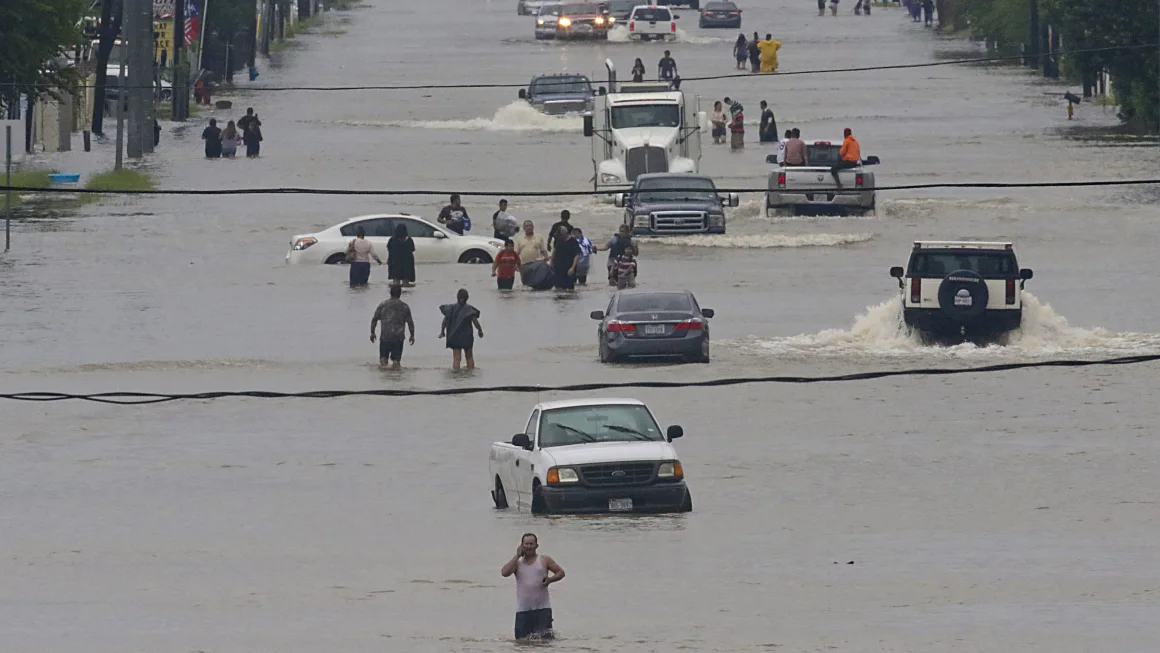Hurricane Harvey struck the state of Texas, causing widespread devastation and catastrophic flooding. The storm, one of the most powerful and destructive hurricanes to ever hit the region, made landfall in late August, dumping unprecedented amounts of rain across the state. The storm’s impact was felt not only in Texas but also in Louisiana and other Gulf Coast states, as Harvey became a symbol of the growing intensity and unpredictability of climate-related disasters.
Hurricane Harvey first made landfall on August 25, 2017, as a Category 4 hurricane near Rockport, Texas. The storm’s winds reached speeds of up to 130 miles per hour, and it brought heavy rain and flooding to vast areas of Texas, particularly the Houston metropolitan area. Over the following days, Harvey slowed to a crawl, causing massive rainfall that led to unprecedented flooding. In some areas, up to 50 inches of rain fell, inundating entire neighborhoods, forcing people to flee their homes, and crippling infrastructure.
Houston, the fourth-largest city in the United States, was especially hard-hit by the storm. The city’s sprawling urban landscape made it particularly vulnerable to the floodwaters. The combination of heavy rain and the already saturated ground from previous storms led to widespread flooding. Streets turned into rivers, and neighborhoods that were once dry became submerged under several feet of water. Thousands of homes were destroyed, and entire communities were displaced as families were forced to evacuate to emergency shelters or seek refuge with friends and relatives.
The floodwaters caused significant damage to homes, businesses, and critical infrastructure, including power lines, highways, and water systems. In many areas, roads were impassable, making it difficult for emergency responders to reach those in need. As floodwaters continued to rise, the situation worsened, and more than 30,000 people were displaced from their homes. At the height of the storm, many residents found themselves trapped, with no way to escape the rising waters. The disaster prompted one of the largest rescue operations in U.S. history, with thousands of volunteers, first responders, and military personnel working together to save lives.
The human toll of Hurricane Harvey was significant. The storm caused at least 88 direct deaths and many more indirectly due to complications such as carbon monoxide poisoning, drownings, and other storm-related accidents. Additionally, the financial cost of the disaster was astronomical, with estimates ranging from $125 billion to $180 billion in total damages. This made Hurricane Harvey one of the costliest natural disasters in U.S. history. Thousands of homes and businesses were destroyed, and many families faced the difficult task of rebuilding their lives from scratch.
In addition to the human and economic toll, the environmental impact of the hurricane was also severe. The storm caused extensive damage to the region’s environment, including the flooding of toxic waste sites and the release of hazardous chemicals into the water. In some areas, floodwaters overwhelmed sewage systems, leading to the contamination of drinking water and increased health risks for affected communities. The storm also caused extensive damage to the oil and gas industry, with offshore oil rigs, refineries, and pipelines affected by the flooding.
In the aftermath of Hurricane Harvey, the response from federal, state, and local governments was swift, but the scale of the disaster made recovery a long-term challenge. The Federal Emergency Management Agency (FEMA) coordinated efforts to provide immediate relief, including search and rescue operations, temporary housing, and financial aid for displaced residents. The U.S. military also played a critical role in assisting with rescue operations, deploying helicopters and boats to reach people stranded by the floods.
At the state and local level, first responders, including firefighters, police officers, and medical personnel, worked tirelessly to provide emergency services and support to the community. Volunteers from across the country also flocked to Texas to assist with cleanup and recovery efforts. Many organizations, including the American Red Cross and local charities, provided food, water, medical care, and other supplies to those in need.
Despite the swift response, the recovery process was slow and challenging. Many areas of Texas faced long-term challenges in rebuilding infrastructure, homes, and businesses. The city of Houston, in particular, had to address issues such as the restoration of the water supply, the repair of public transit systems, and the rebuilding of flood-damaged homes. The long-term environmental impact of the storm also posed significant challenges for communities and local governments, as they worked to clean up contaminated areas and prevent further damage.
Hurricane Harvey also raised important questions about the role of climate change in the increasing intensity and frequency of extreme weather events. While it is difficult to directly attribute any single storm to climate change, many scientists believe that rising sea surface temperatures and changes in atmospheric conditions are contributing to the increasing severity of storms like Harvey. The storm highlighted the vulnerability of communities along the Gulf Coast and other coastal areas to such extreme events and underscored the need for better infrastructure, disaster preparedness, and climate action to mitigate future risks.
In the years following Hurricane Harvey, the state of Texas has worked to rebuild, with many communities still dealing with the aftermath of the storm. The disaster also served as a reminder of the importance of resilience in the face of natural disasters and the need for collaboration between federal, state, and local governments, as well as the private sector and citizens, to prepare for and respond to future challenges.






